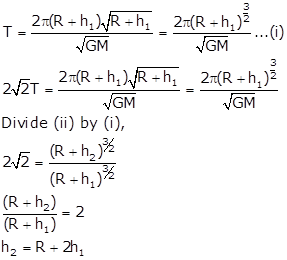Class 10 MAHARASHTRA STATE TEXTBOOK BUREAU Solutions Science Chapter 10 - Space Missions
Space Missions Exercise Ex. 10
Solution 1
a. If the height of the orbit of a satellite from the earth surface is increased, the tangential velocity of the satellite will decrease.
![]()
b. The initial velocity (during launching) of the Mangalyaan, must be greater than escape velocity of the earth.
Since, 24th September 2014, the mars Orbiter Mission, also known as Mangalyaan, has been orbiting Mars. It was launched by ISRO on 5th November 2013.
The initial speed of Mangalyaan must be higher than escape speed of the earth i.e., 11.2 km/s.
Solution 2
a. False
The minimum velocity with which the spacecraft must be projected so that it escapes the Earth's gravitational pull is known as escape velocity. So initial velocity of spacecraft must be greater than or equal to escape velocity of Earth.
b. True
![]()
As the acceleration due to gravity on moon is one - sixth of that on Earth, thus the escape velocity that on the Earth.
c. True
The specific velocity with which satellite revolves around a planet is known as critical velocity.
![]()
It can be observed that the critical velocity of a satellite changes depending on the height of the orbit from the surface of a planet.
Thus, to revolve in a specific orbit, a satellite would require critical velocity.
Solution 3a
Artificial satellite - A manmade object revolving around a planet in a fixed orbit is known as artificial satellite.
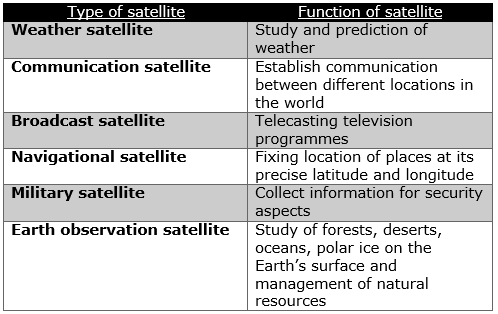
Solution 3b
An orbit is a specific path around a planet in which satellite revolves. Depending on height of satellite's orbit above the earth's surface, the satellite orbits are classified as
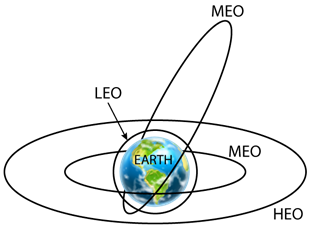
Height Earth Orbit: (HEO)
· Orbits at a height greater than 35,780 km above the Earth's surface.
· They take 24 hours to complete one revolution. Hence, they are also called geosynchronous satellites.
· Used in meteorology and for carrying telephone, television and radio signals.
Medium Earth Orbit: (MEO)
· Orbits between the range of 2000 km and 35,780 km height above the Earth's surface.
· Some of these satellites revolve at a height of 20,200 km above the Earth's surface.
· Takes 2-24 hours to complete one revolution.
Low Earth Orbit: (LEO)
· Orbits at a height ranging between 180 km and 2000 km.
· Used for experiments and atmospheric studies.
· These satellites complete one revolution in 90 minutes.
· Examples: International Space Station and Hubble telescope
Solution 3c
Geo-synchronous satellites are design revolve around equator line of earth or to any specific position like land, county or region. So, it revolves with same time period as earth do. So, these satellites never need to cross any poles, that's why geostationary satellites can't be use for pole studies.
Solution 3d
Satellite launch vehicles are used, to place the satellites in their specific orbits.
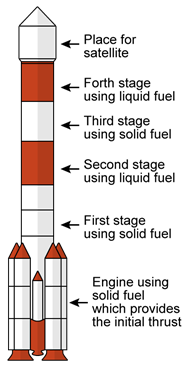
Working of two-stage launch vehicle:
For launching the vehicle, the fuel in the first stage is used.
This stage imparts a specific velocity to the vehicle and helps the satellite to acquire a certain height.
When the fuel in the first stage is exhausted, the second stage is ignited. The first stage gets separated from the vehicle.
As the vehicle only has one stage, it can move with a higher speed.
Finally, when the fuel from the second stage gets completely exhausted, the second stage gets separated and the satellite gets launched in its designated orbit. The space shuttle returns to the Earth.
Solution 3e
The structure of the launch vehicle is decided by the weight of the satellite and the type of satellite orbit. The fuel of the vehicle also depends on these factors. The fuel forms a major portion of the total weight of the launch vehicle. Thus, the vehicle has to carry a large weight of the fuel with it. To overcome this problem, launch vehicles with more than one stage are used. Due to this, the weight of the vehicle can be reduced step by step, after its launching.
Solution 4
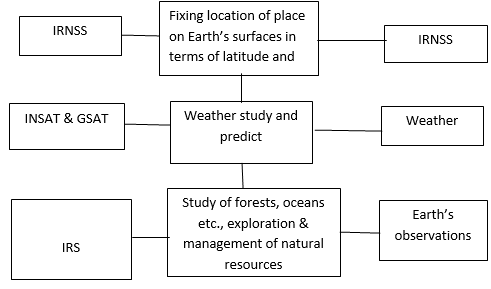
Solution 5a
Escape velocity of Earth is
![]()
Mass of planet, MP = 8 x Mass of the Earth (Me)
Radius of planet, RP = 2 x Radius of the Earth (Re)
Thus, escape velocity of planet is,

Solution 5b
h = 35780 km
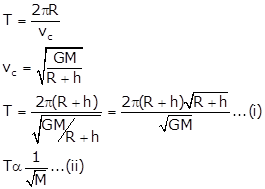
From eq (ii)
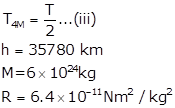
Putting values of h, M and R in first we get
T = 24 h
Using (iii), we get,
![]()
Solution 5c
When height is h1, it takes time T to revolve around the earth while let the height be h2 when the satellite takes 2√2T to revolve around earth
